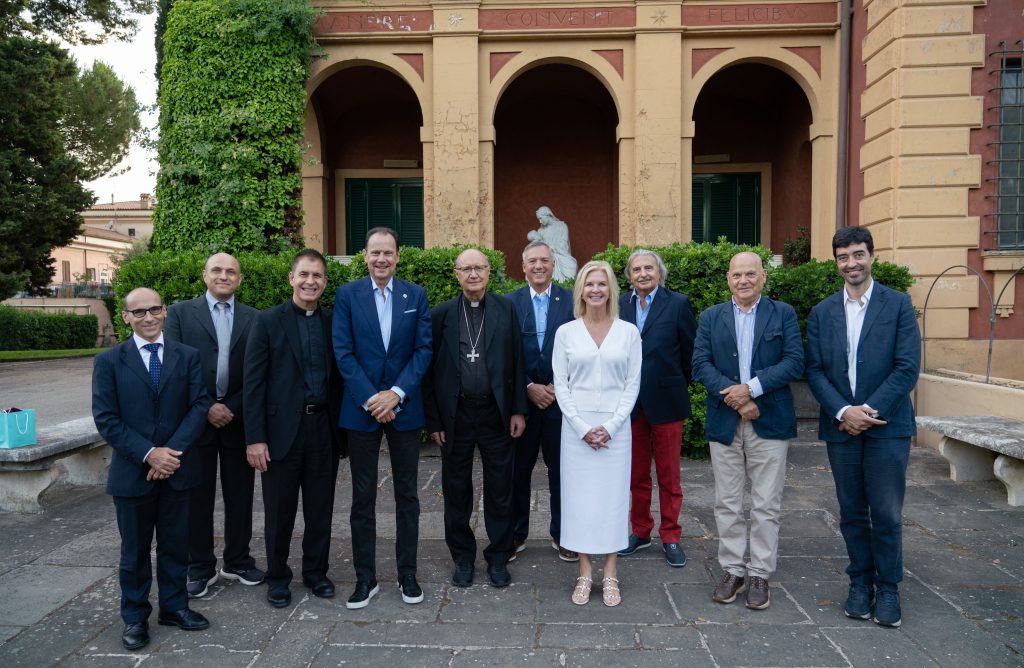“It was an extraordinary chance to come to Rome, to the center of the church,” said Tetlow, who went on the pilgrimage with family, trustees, and alumni. “It was a chance for the board and other friends of Fordham to commit to the mission and to understand the broader global church, and it was pretty special inspiration for me as I begin the work ahead.”
A Pilgrimage to the ‘Heart of the Church’
The pilgrimage was inspired by the life of Iñigo de Loyola, a young soldier from a noble Basque family in the 1500s who once sought fortune and fame. When his leg was shattered by a cannonball in battle, he spent months recovering at his family home. It was during this crucial time that he began learning about Jesus and the lives of the saints. These stories and this period of discernment in recovery inspired his spiritual conversion. He decided to dedicate the rest of his life to the service of God and humankind.
Iñigo de Loyola, now known as St. Ignatius, went on to co-found the Society of Jesus in 1540. He and his religious brothers made their first home in Rome, where they lived in a small house between what is now the Piazza di Spagna, the “Spanish Steps,” and the Piazza del Popolo. Today, the Society of Jesus is the largest male religious order in the Catholic Church.
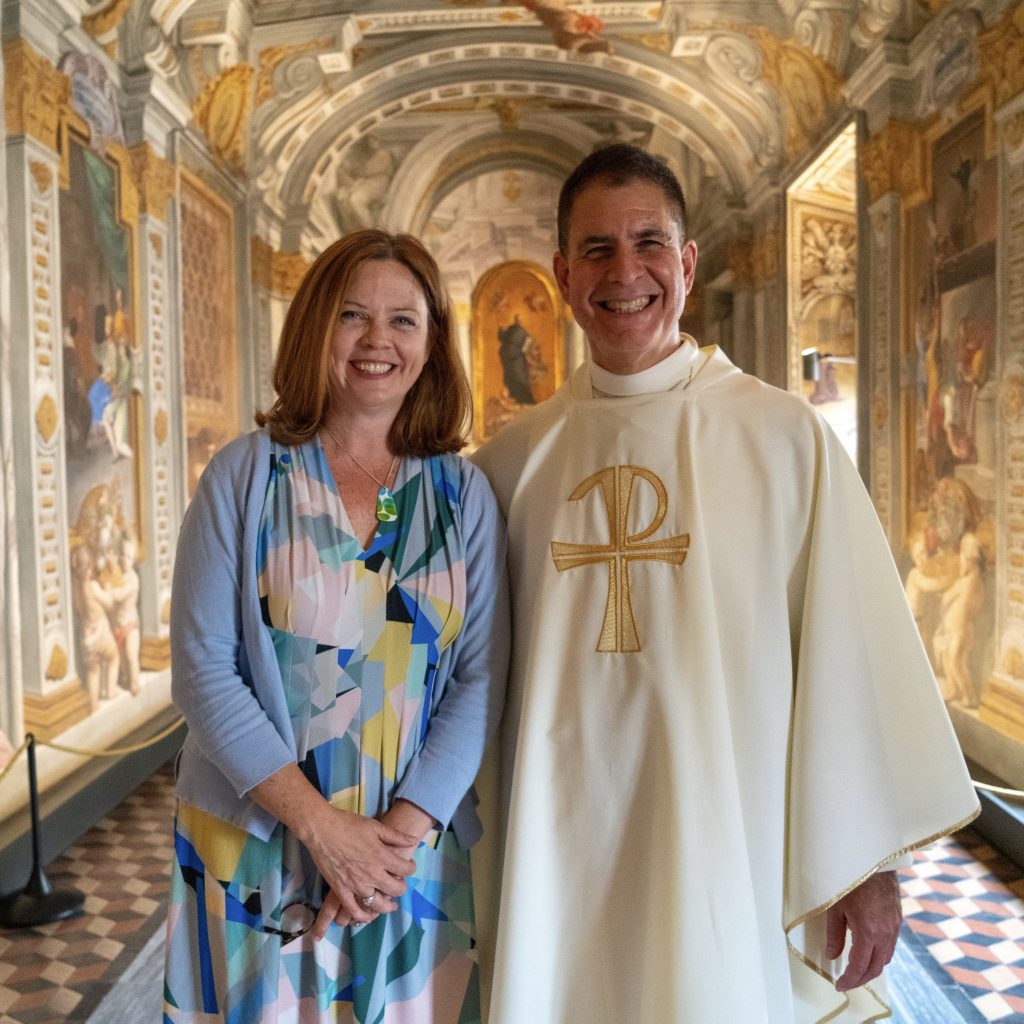
In honor of the 500th anniversary of St. Ignatius’ conversion, Jesuit communities across the world have been participating in a yearlong celebration, the Ignatian Year, beginning on May 20, 2021. Fordham has hosted celebratory events since last spring and will continue the celebration of St. Ignatius and his legacy until July 31, 2022, the Feast Day of St. Ignatius Loyola.
The Fordham trip to Rome served as the highlight of the yearlong celebration, featuring the University’s new leader, Tetlow: the first layperson and woman to lead the Jesuit University of New York.
“The timing of this trip couldn’t have been better as we transition now to our first lay president. It reinforces our responsibility as trustees to ensure the awareness of our Jesuit ideals, mission, and identity, and it’s our firm belief that through all of this, we can be—even with a lay president—more of a Jesuit university than we were previously,” said Armando Nuñez, GABELLI ’82, chair-elect of Fordham’s Board of Trustees.
The pilgrimage was also a “special” experience for the nearly two dozen members of the Fordham community who traveled to Rome, said John Cecero, S.J., vice president for mission integration and ministry.
“Coming here to the heart of the church, to have these conversations and to generate that awareness, was so special,” said Father Cecero. “To come here and walk in the steps of Ignatius, visit the sites that were so important to him, and meet the leaders of the church has been so precious.”

Exploring the Life and Home of St. Ignatius
On the first day of the trip, those who were fortunate enough to escape the effects of jet lag explored the beginnings of Christianity in Rome. They first visited the Roman Forum, the ruins of ancient government buildings, where they learned about the Roman context of early Christianity with an archaeologist. Then they visited the Basilica of San Clemente, a set of three tiered churches from the 1st, 4th, and 12th centuries, featuring detailed Christian mosaics.
The next day, the Fordham delegation immersed themselves in the life of St. Ignatius. In a series of guided tours, they explored the Santa Maria Maggiore, where St. Ignatius said his first Mass; the Gesù, the first Jesuit church in Rome that became the final resting place for St. Ignatius; and the Church of St. Ignatius.
“The Church of St. Ignatius is a beautiful and central place for us, not only because it contains the remains of the saints Aloysius Gonzaga, John Berchmans, and Robert Bellarmine, but also the architecture, art, and ceiling of the Jesuit artist Andrea Pozzo,” said Father Cecero. “All of this speaks to the Jesuit emphasis on integrating art, science, and beauty as an expression of God’s creation and as a way to reflect back to God our gratitude for his creation and the beauty that surrounds us.”
In a private tour, Tetlow and the Fordham delegation also explored the building where St. Ignatius directed the Society of Jesus as their first Superior General. It was here that he wrote the Constitution of the Society of Jesus, as well as handwritten letters to Jesuits who lived across the world.
In a small room, Father Cecero held a group liturgy and Tetlow, a professionally trained opera singer, sang the “Salve Regina.” Later that afternoon, they visited the Basilica of St. Paul Outside the Walls, the church where St. Ignatius and his early companions made final vows after the founding of the Jesuit order.
“St. Ignatius is my saint,” said Ignacio Fernández de Lahongrais, GABELLI ’87, whose great-uncle, father, and son all share the same first name. “It was very emotional to have Mass where St. Ignatius gave Mass. It was also absolutely wonderful to be where he lived and to learn more about his life and what he stood for.”
An Inspiring Message From the Vatican Prefect for Catholic Education
On the third day of the trip, the Fordham delegation traveled to the Vatican City, where they met Cardinal Giuseppe Versaldi, Vatican prefect for Catholic education, and Monsignor Guy-Réal Thivierge, secretary general of the Pontifical Foundation Gravissimum Educationis.
In an address to the Fordham delegation, Cardinal Versaldi discussed the importance of teaching about an inclusive faith through Catholic education. He emphasized that schools should maintain their core Catholic values, but continue to respect and welcome people from all walks of life. In addition, he applauded Fordham for its quality of education in a modern world.
“I’m sure you will continue this communion with the church, keeping your autonomy and your independence, but also the capacity to work together and to offer a contribution to a new world,” Cardinal Versaldi, who prompted the Society of Jesus to create the Mission Priority Examen, said to the Fordham delegation.
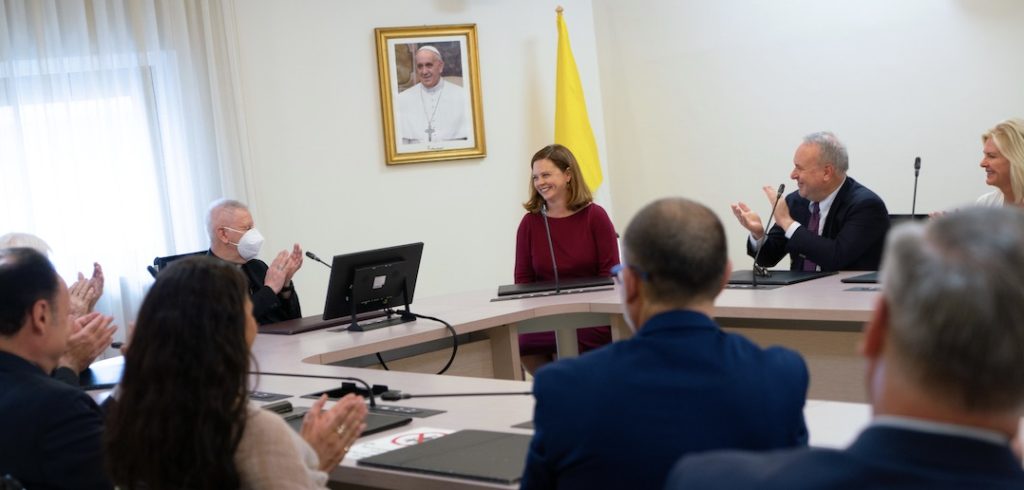
The cardinal’s message was inspiring, particularly for those who grew up in a period that was less inclusive, said Elizabeth “Betty” A. Burns, FCLC ’83, a former trustee who was raised Catholic. The cardinal’s speech was also surprising in a positive way, said Robert Smolens, husband to Donna Smolens, FCRH ’79, GSAS ’81.
“I thought he would be a little more dogmatic and concerned about, as he put it, this secularization that’s going on in the world. It’s not the same place that it was 30, 40 years ago, when my wife and I were in school,” said Smolens, who was raised in a Jewish household and is married to a Catholic. “But he welcomes the challenge of 2022, and that’s what we need to still have a great Catholic university.”
The overall message from the cardinal and his associates is important to Fordham and its mission, said Kim Bepler, a University trustee and philanthropist who earned an honorary doctorate from Fordham this May.
“It was so inspiring and forward-thinking to hear what the monsignor and the cardinal had to say about the Catholic identity, the mission of the Jesuits, and that we don’t lose sight of the mission of Fordham,” said Bepler. “We are inclusive, and we are also welcoming. As the educational model changes, we change—and it’s for the better.”
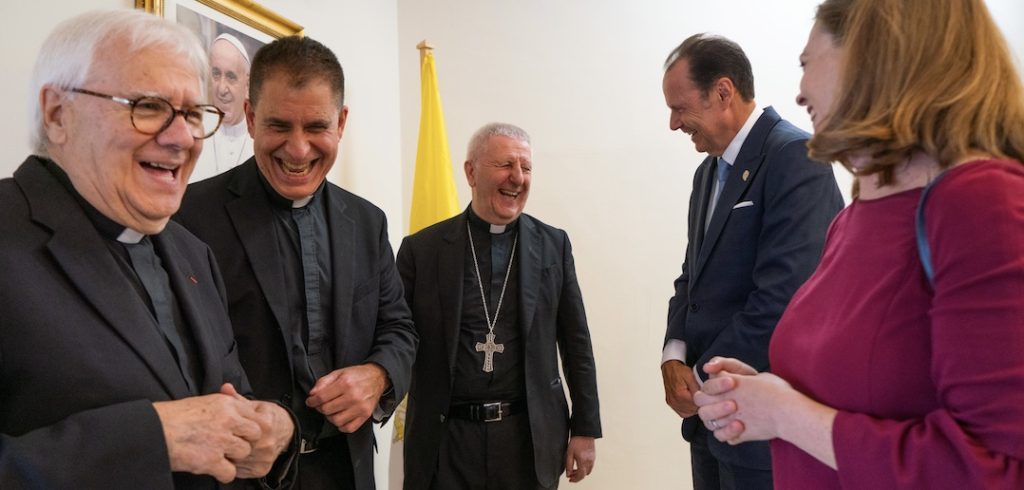
Meeting the Vatican Secretary of State
On their final day of the trip, the delegation met Cardinal Pietro Parolin, Vatican secretary of state, in the heart of Vatican City. The Fordham delegation awaited the cardinal in the Apostolic Palace, the official residence of the pope, where they sat in ornate chairs and were surrounded by elaborate paintings. For a few minutes, the room was silent except for hushed whispers and the continuous ticking of a grandfather clock. When the cardinal arrived from an entrance in the corner of the room, everyone immediately rose from their seats.
In a 20-minute speech, the cardinal echoed the words of his associates and wished the Fordham delegation well on their trip.
“It is my hope that on your pilgrimage to Rome, your experience of Christian sites and your visits to places associated with the life of St. Ignatius will prove inspiring and sustain you in joyful and hope-filled love for Christ and one another,” Cardinal Parolin said to the Fordham delegation.

Tetlow thanked him for his words and offered her own thoughts on the future of Catholic education. Historically, Catholic schools and universities have offered opportunities to students from all different backgrounds, including immigrants and first-generation students, she said. Their core mission has been supported by not only priests, but the lay people, she added.
Now, in a time when the U.S. and the American Catholic Church are increasingly divided, Fordham’s Catholic identity offers a reminder of our common values and the need to serve the common good, she said. She also acknowledged that Fordham serves students from many faiths, increasingly those who have no religious background. It is important that the University does not “preach to the choir,” but encourage respect for the church, the Catholic faith, and people from all walks of life, she said.
“We ask students to put aside their own ideas and be willing to think of new ideas and to embrace faith and spirituality, and we teach that openness by modeling it ourselves,” she said to Cardinal Parolin. “It is not an easy task right now, but we work very hard to make that manifest at Fordham, which is one of, as you described, the finest Catholic universities in the world. And so it is a great responsibility for me—for this board, for this community—to do that well, and it is the privilege of our lives to serve the church in this way.”
At the end of their exchange, Tetlow gifted Cardinal Parolin with a Fordham baseball cap. The cardinal immediately placed it over his red skullcap and waved at the staff photographer, while the Fordham delegation laughed appreciatively. As the delegation filed out of the room, he handed each member a blessed rosary.
“I love the fact that we’ve got more Fordham baseball caps wandering around Rome,” Kim Bepler later said during a car ride in Rome.
“We did leave one for the pope, so maybe we’ll see him appear on the balcony someday with a Fordham cap on,” said Father Cecero, chuckling. (Pope Francis was unfortunately unable to meet with the Fordham delegation.)

A Visit to the Jesuit Headquarters to Meet the Superior General
Later that afternoon, the Fordham delegation met Arturo Sosa, S.J., superior general of the Society of Jesus, on the rooftop of the Jesuit Curia in Rome—the headquarters of the Jesuits.
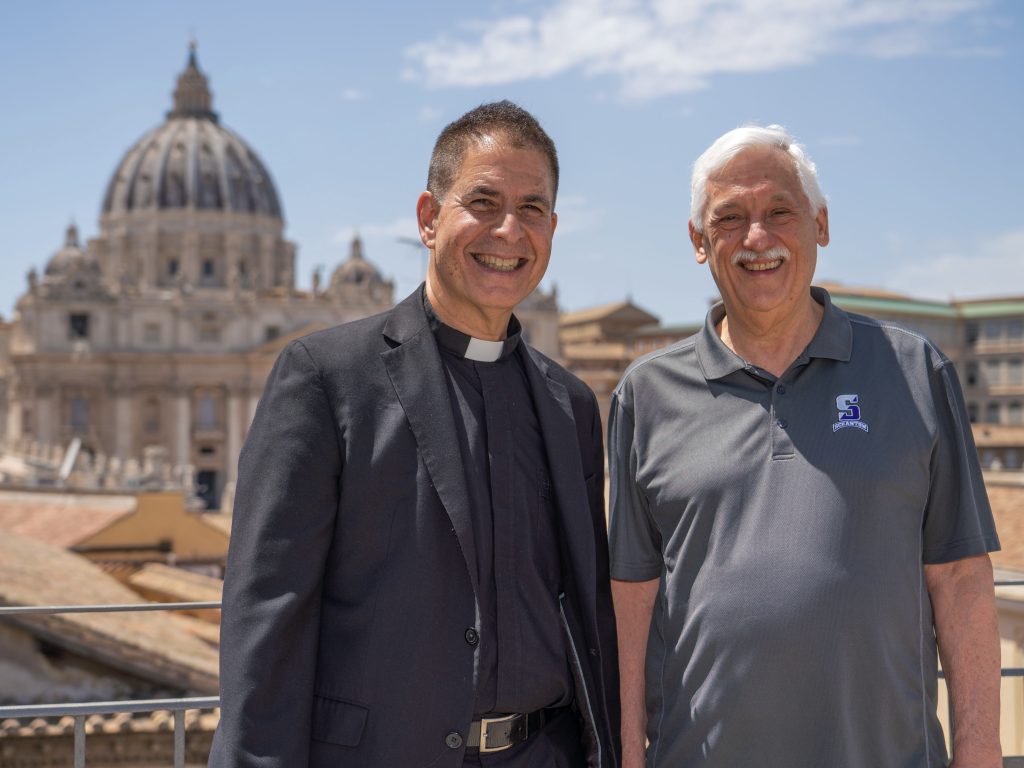
“It was a real treat to meet the Father General. He was wise and wonderful and a lot of fun,” said Tetlow, who shared a private meal with him. “[We talked about] matters big and small: the transition to lay leadership, the state of Jesuit universities in the U.S. and around the world, and opportunities for all of us to partner more with each other across national borders.”
Afterward, the Fordham delegation toured the Curia, including the chapel, gardens, and the dining room, where they sampled freshly picked fruit from the Curia’s own backyard.
In the delegation’s final outing as a group, Father Cecero held Mass at Sant’ Andrea al Quirinale, the third Jesuit church constructed in Rome, where young novices once studied. People offered prayers—for the people of Ukraine, for Tetlow and her family as they start their new journey at Fordham, and for Father Cecero, who spearheaded the pilgrimage.
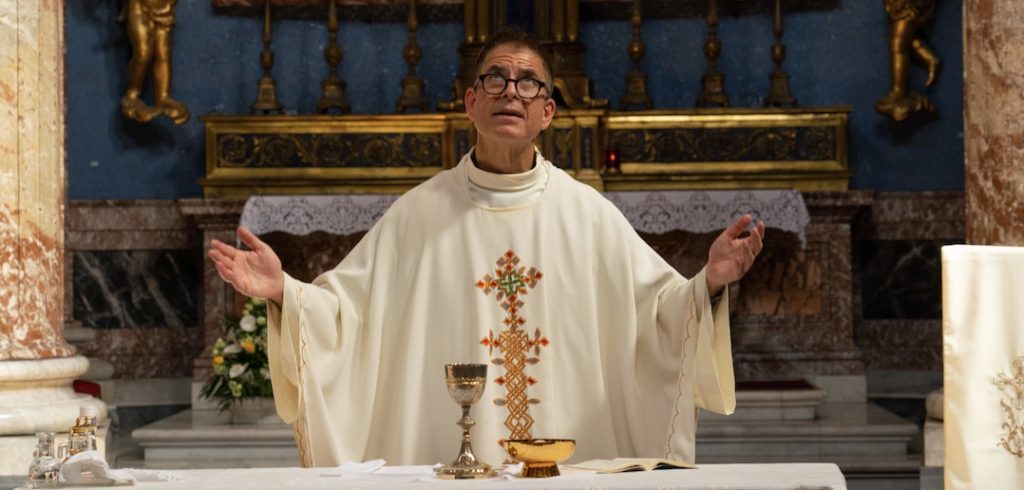
Returning Home with A New Vision for Fordham
Each Vatican official from the pilgrimage affirmed the importance of “service, engagement, and encounter”—three concepts that are critical to the mission of Fordham’s Center for Community Engaged Learning, said the center’s executive director, Julie Gafney, Ph.D., who was part of the Fordham delegation.
“This is so crucial because this is the work that the center does at Fordham. We often talk about our mission internally at Fordham, but to hear these leaders express that this is the bedrock on which our educational tradition is founded—and also an area for innovation in education—was so powerful and something I want to bring back and continue to grow at Fordham,” said Gafney.
Gafney said that many Jesuit schools have become strong research institutions, but it’s important for them to remember the roots of the Jesuit tradition: educating young people, especially those from underprivileged backgrounds.
“Our center offers tutoring, mentorship, college access programming, and mental health services to youth-serving nonprofits and local schools in partnership with faculty and students. I’d really like to scale and increase those forms of engagement, since they can be deeply impactful and align powerfully with our mission,” said Gafney, who also oversees programs like Urban Plunge and Global Outreach. “I’d like to have 1,000 Fordham students serve as tutors and mentors. It’s doable. It’s needed. And I think it could be really powerful—both for the middle and high school students and the Fordham undergraduates.”
Building Relationships Abroad
On the last day of the pilgrimage, several members of the Fordham delegation visited Villa Nazareth, a Vatican-affiliated residential college for talented students from low socioeconomic backgrounds in Italy, where they toured the facilities, interacted with present students, and discussed an invitation from Cardinal Parolin to establish a partnership with Fordham.
The school was established in 1946, one year after World War II ended, to help orphans reach their potential. Since then, Villa Nazareth has become a prestigious institution that educates and houses students, free of charge. The institution, managed by a nonprofit called the Comunitá Domenico Tardini Association, has received attention from many visitors, most notably Pope Francis in 2016, and is led by Cardinal Parolin.
The visit was an opportunity for Fordham to expand its global footprint and establish a new relationship with a school in Rome that shares the same mission.
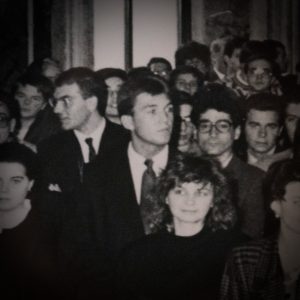
“The mission of our schools is to deliver cura personalis, and what you have described about what happens here is exactly that—to care for the whole student,” Father Cecero said, addressing administrators at Villa Nazareth after listening to a PowerPoint presentation about the school’s mission. “You’ve given us important seeds to ponder about how we can creatively work with you because we share a very common mission.”
The visit was also a homecoming for Roger A. Milici Jr., vice president of development and university relations at Fordham, who studied at Villa Nazareth in 1986 and 1987. On the wall of a campus building, Milici pointed to a black-and-white group photo of students from several decades ago, featuring his 21-year-old self. “It feels like yesterday,” he said.
Archbishop Claudio Celli, deputy president of Villa Nazareth, embraced the potential of a new partnership with Fordham.
“Your people can be here, and our people can go to Fordham,” Archbishop Celli said to the Fordham delegates in the room. “This is just the beginning—but we can see the future.”
This article is part of a series of stories about the Rome pilgrimage.
